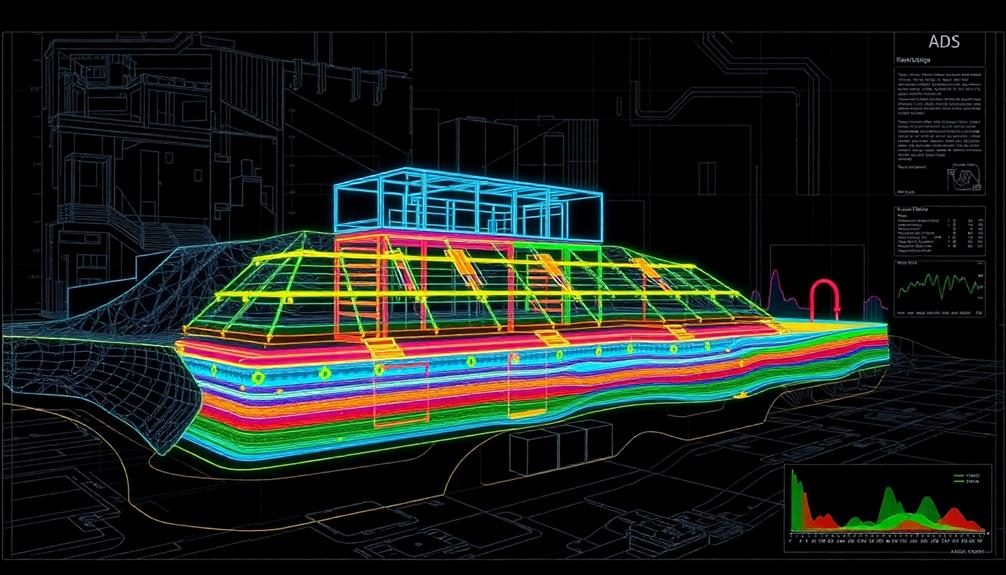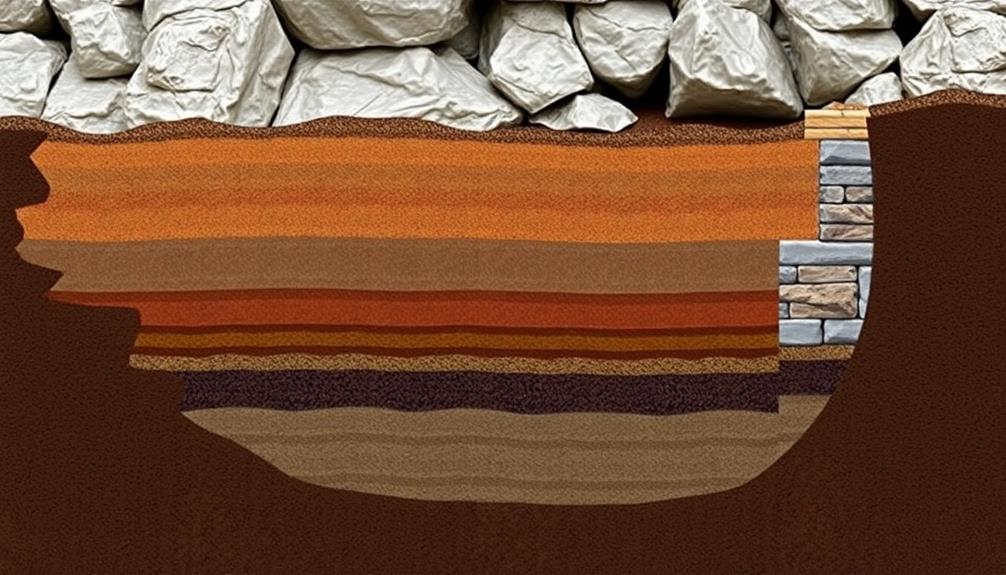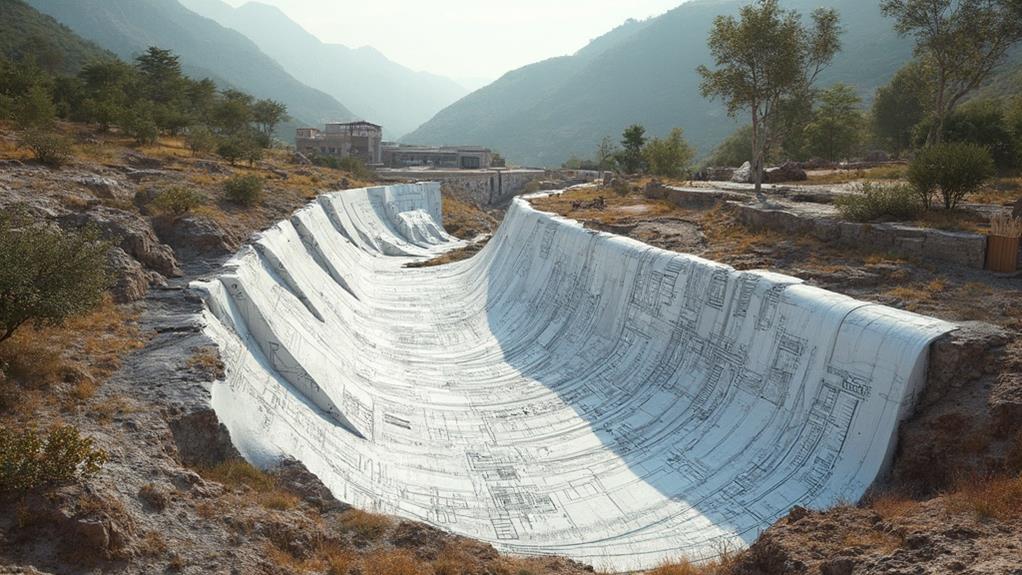When utilizing retaining wall engineering software, carefully assess the integration of advanced computational tools that streamline complex calculations and analysis. Consider the software's adherence to evolving industry compliance standards, which guarantee structural safety and environmental sustainability. Pay attention to features that offer precise design capabilities, enhancing both the reliability and efficiency of your projects. Evaluate its ability to simulate environmental factors, such as seismic activity and hydrostatic pressure, to foresee challenges and optimize design solutions. Additionally, consider tools for soil compatibility analysis to accurately assess load-bearing capacity and drainage solutions. Explore further for a deeper understanding of these critical aspects.
Table of Contents
ToggleWalls Contractor Highlights
- Ensure the software aligns with current industry regulations and compliance standards.
- Evaluate the software's ability to simulate real-world conditions and environmental factors accurately.
- Assess the user-friendliness and intuitiveness of the software interfaces.
- Verify the software's capacity for integration and collaboration across project components.
- Confirm the software includes analytical tools for precise design and cost estimation.
Definition of Retaining Wall Software

Retaining wall software is specifically designed to facilitate the purpose and functionality of engineering retaining structures, providing thorough tools for design and analysis that guarantee stability and performance. These tools incorporate advanced algorithms that simulate real-world conditions, enabling engineers to evaluate diverse scenarios with precision while adhering to compliance and standards set by industry regulations.
Boulder retaining walls are a popular choice for their natural aesthetics and long-lasting durability, which can be effectively modeled using such software. By integrating these capabilities, the software provides a robust framework for developing reliable and efficient retaining wall solutions.
Purpose and Functionality
Understanding the purpose and functionality of retaining wall engineering software is essential for civil engineers and architects who are tasked with designing stable and efficient retaining structures. This specialized software plays a pivotal role in facilitating the intricate process of retaining wall design by amalgamating advanced computational capabilities with user-friendly interfaces. It serves as a virtual toolset, allowing engineers to craft detailed models that simulate various scenarios and complexities inherent in soil-structure interactions.
The core functionality revolves around providing analytical insights that help in verifying the stability and safety of retaining walls under a myriad of conditions. By incorporating complex algorithms, such software can simulate environmental factors, such as seismic activity and hydrostatic pressure, to predict potential failure modes. This not only confirms that structural integrity is maintained but also optimizes material usage, aligning with both safety and sustainability objectives.
Furthermore, retaining wall software often incorporates compliance guidelines, assisting users in adhering to regional and international construction codes. This integration enhances the reliability of engineering decisions, verifying projects align with industry standards. Through its precise calculations and scenario-testing capabilities, retaining wall engineering software becomes indispensable in the quest for building structures that are both resilient and economically viable.
Design and Analysis Tools
Innovation in construction engineering has led to the development of retaining wall software that serves as an essential design and analysis tool for professionals in the field. At its core, this software combines advanced computational algorithms with user-friendly interfaces to assist engineers in visualizing, designing, and analyzing retaining wall structures.
By streamlining complex calculations, these tools help guarantee structural integrity and longevity, accommodating a diverse array of materials and site conditions.
Key features of retaining wall software often include interactive modeling capabilities, which allow for the adjustment of various parameters, such as wall height, soil type, and loading conditions, facilitating an iterative approach to design refinement. The ability to simulate real-world scenarios ensures that engineers can predict and mitigate potential issues before construction commences.
Additionally, the integrated analysis modules assess the stability and safety of proposed designs, offering critical insights into potential stress points or failure risks.
Compliance and Standards
Adhering to compliance and standards is pivotal when utilizing retaining wall engineering software, as these tools must align with the myriad of regulations governing structural safety and environmental considerations. The necessity for compliance emerges from the prerequisites set forth by local, state, and international building codes, which are designed to guarantee the integrity and safety of constructed environments. Engineers and professionals in the field acknowledge that catering to these standards not only prevents legal ramifications but also augments the reliability and efficiency of the construction.
Hence, retaining wall software should be equipped with capabilities to seamlessly integrate these compliance parameters within its analytics processes.
Furthermore, staying abreast of evolving regulations is indispensable as engineering landscapes continuously shift to accommodate advancements and sustainability goals. Software that incorporates up-to-date code amendments and best practices offers users a robust framework, allowing professionals to design with confidence. In a community where safety and environmental sustainability are core values, utilizing toolsets that embody these principles fosters a sense of assurance among stakeholders.
As a result, choosing software that is compliant with these standards is not simply about meeting regulations; it is about embracing a commitment to excellence and community welfare, reinforcing a shared vision of safe and resilient structures.
Benefits

The adoption of retaining wall engineering software offers significant benefits, beginning with its ability to improve design precision by utilizing advanced algorithms and thorough data analysis. These tools can assist in evaluating site conditions and topography, which are indispensable for determining appropriate wall materials and design solutions.
Additionally, it streamlines the design process, leading to considerable savings in time and effort, while simultaneously aiding in the generation of dependable cost estimates that are essential for project planning and budgeting. By incorporating up-to-date compliance standards, it confirms that designs meet regulatory requirements, thereby mitigating potential risks and aligning with industry best practices.
Enhances Design Accuracy
Countless advancements in retaining wall engineering software have revolutionized the precision of design accuracy for civil engineers and architects. In an era where structural integrity and environmental compatibility are paramount, the capability to predict and refine designs with unmatched precision has fortified the professional landscape.
By leveraging sophisticated algorithms and robust data integration, contemporary software guarantees that every engineering project aligns steadfastly with analytical models. This deep fidelity in design not only fosters confidence in blueprints but also reduces the likelihood of structural failures, aligning seamlessly with industry-wide best practices.
Moreover, this software empowers professionals to make informed decisions by providing a virtual testing bed for various design scenarios. The ability to visualize potential challenges and iterate on designs quickly verifies that any arising discrepancies are addressed long before physical construction.
Such meticulous attention to detail nurtures a collective professional identity founded upon reliability and expert craftsmanship. By adopting these advanced tools, engineers and architects alike contribute to a community dedicated to safely transforming visions into reality. As software innovation progresses, it upholds the standard of excellence expected within this meticulous field, offering a bedrock of accuracy and a manifestation of shared commitment.
Saves Time and Effort
How greatly can retaining wall engineering software streamline the design process for professionals? This software substantially reduces time and effort by automating complex calculations and integrating design workflows. It allows engineers to bypass repeated manual computations, expediting the entire process from conceptualization to final designs. User-friendly interfaces enable the input of project specifics, while underlying algorithms rapidly process data to generate optimal solutions, all while maintaining stringent standards of safety and functionality.
Furthermore, retaining wall engineering software consolidates various components of the design process into a single platform, fostering collaboration among professionals and enhancing the cohesiveness of project development. This integration minimizes data redundancies and errors, allowing engineers to focus on design refinement rather than logistical challenges. Team members can access and modify designs in real-time, thereby facilitating a collaborative environment where ideas and expertise flow unimpeded among peers.
Reliability is paramount, and by providing access to a vast library of design codes and material specifications, this software guarantees that designs adhere to requisite industry standards. This accessibility and functionality engender a sense of belonging among users, uniting them in a shared pursuit of engineering excellence and efficiency.
Improves Cost Estimates
Streamlining cost estimation emerges as a pivotal benefit of utilizing retaining wall engineering software. Engineering professionals often face the challenging task of calculating accurate cost estimates, balancing precision with time efficiency.
Sophisticated software solutions bring clarity and precision to budgeting processes, making it easier to allocate resources effectively and reduce unforeseen expenses. By automating and integrating various processes, these tools enhance the capability of estimating financially sound projects.
Retaining wall engineering software offers several advantages that go beyond basic computations:
- Automated Calculations: The software automates complex calculations, reducing human error while saving valuable time, which can then be diverted to address more strategic project elements.
- Resource Optimization: The software facilitates efficient use of materials by suggesting alternatives or optimized material usage, thus minimizing costs without compromising structural integrity or design aspirations.
- Scenario Analysis: Users can input varying parameters to evaluate multiple design scenarios, enabling them to predict and prepare for potential financial outcomes across a range of project options.
- Centralized Data Management: Consolidating all data into one accessible platform removes redundancy and streamlines communication between team members, ensuring coherent and consistent cost tracking.
These features collectively foster a collaborative environment where members feel equipped and connected, aligned in achieving project objectives efficiently.
Ensures Compliance Standards
The precision in cost estimation achieved through retaining wall engineering software naturally extends to maintaining compliance with industry standards. This technology provides a framework that inherently incorporates the myriad of regulations that govern structural stability, safety, and sustainability. Integrating up-to-date codes and guidelines directly into the software certifies that every step of the design and construction process adheres to national and local mandates. This compliance not only fortifies the engineering process but also instills confidence for engineers and stakeholders, forming a communal sense of responsibility and trust.
Moreover, the software assists users in aligning project specifications with both current and evolving standards. Automatic updates feature prominently, capturing changes in legislation and standards that impact engineering practices. This reduces the risk of human error and oversight, which can lead to costly revisions or non-compliance penalties. Additionally, detailed reporting functions expedite the documentation process, providing comprehensive records that demonstrate adherence to compliance during audits and inspections.
Engineers and planners can take comfort in knowing their work fulfills all necessary standards, contributing to a collaborative ethos within the industry. This assures that structures not only meet safety and performance benchmarks but also resonate with a shared commitment to quality and reliability.
Soil Compatibility Considerations

In the domain of retaining wall engineering, the compatibility of soil plays a crucial role in ensuring structural integrity and longevity. To achieve an optimal design, engineering software must analyze soil properties to understand the texture and composition, assess the load-bearing capacity to predict how much weight the soil can support, and evaluate drainage solutions to mitigate water-related erosion and pressure. Below is a table showcasing key considerations:
| Aspect | Importance | Software Functionality |
|---|---|---|
| Soil Properties | Understanding texture and type | Analyze and report soil conditions |
| Load Bearing Capacity | Predicting structural support | Calculate pressure and weight distribution |
| Drainage Solutions | Preventing water-related issues | Design effective water management systems |
This thorough approach allows for designs that accommodate site-specific challenges, ultimately enhancing the safety and efficiency of retaining wall projects.
Analyze Soil Properties
Understanding soil properties is pivotal when evaluating soil compatibility for retaining wall engineering. Utilizing retaining wall engineering software effectively requires a thorough examination of soil characteristics, which deeply influence the wall's design and performance.
- Soil Type: Distinguish between clay, sand, silt, and loam, each offering different drainage capabilities and cohesive qualities. The interaction of these particles determines how well the soil will respond to pressure and support structures.
- Moisture Content: Water within the soil not only affects weight but also its shear strength. Elevated moisture levels can result in saturation, reducing soil stability and requiring recalibration of retaining wall designs to accommodate variations in hydrostatic pressure.
- Soil Density and Compaction: Appraising soil compaction ascertains that the soil has the suitable density to support load pressures without excessive settlement. Ideal compaction contributes to the overall strength and durability of the retaining wall.
- Soil Permeability: This is critical for identifying potential soil erosion or water retention issues. Highly permeable soils may require additional drainage solutions, while low permeability necessitates consideration of water buildup effects.
Assess Load Bearing Capacity
Frequently, determining the load bearing capacity of soil is a crucial step in ensuring the structural integrity of retaining walls. This examination involves evaluating the compatibility of soil properties with the predicted loads that the wall will encounter over time, acting as a critical juncture between design and reality. Retaining wall engineering software aids in this process by providing simulation capabilities that evaluate various scenarios, from static to dynamic loads, allowing engineers to predict potential challenges.
Understanding soil compatibility is essential, as soils vary greatly in composition, moisture content, and compaction levels. Poorly compacted or loosely aggregated soils can lead to significant failure risks, affecting the wall's stability. Using the software, engineers can input soil type data—such as clay, silt, sand, or gravel—and evaluate how these will interact with the proposed structure. By simulating various environmental conditions, the software aids in forecasting how soils will behave under pressure, thus determining if reinforcements or soil amendment strategies are necessary.
Ultimately, carefully examining soil compatibility fosters a sense of security among stakeholders, ensuring that the retaining wall will not only meet engineering standards but also provide long-lasting benefits to the community it serves.
Evaluate Drainage Solutions
Evaluating soil compatibility not only influences load-bearing calculations but also plays a critical role in examining drainage solutions for retaining walls. Understanding the complex interaction between soil and water is essential for designing efficient drainage systems that prevent structural failures and erosion.
Soil characteristics directly affect water permeability, necessitating a tailored approach to drainage based on site-specific conditions. When utilizing retaining wall engineering software, it becomes imperative to ponder how different soils will comport with proposed drainage strategies.
To adequately address the nuances of soil compatibility, examine the following:
- Soil Type Identification: Determine the soil classification—whether it's sandy, clayey, or loamy—to assess its drainage properties.
- Permeability Tests: Conduct thorough permeability tests to gather quantitative data that guides drainage design, ensuring that water moves efficiently through and away from the structure.
- Runoff Calculations: Utilize software to accurately calculate potential surface runoff, particularly under varying weather conditions, to design resilient drainage paths.
- Erosion Control Measures: Incorporate erosion control techniques, such as geotextiles or rip rap, where soils are highly susceptible to water-induced erosion, ensuring long-term wall stability.
Walls Contractor FAQ
What Are Common Mistakes to Avoid When Using Retaining Wall Engineering Software?
When employing retaining wall engineering software, common pitfalls include neglecting adequate input accuracy, overlooking software updates, and failing to verify results against established engineering principles. Ensuring meticulous attention to detail promotes successful and effective project outcomes.
How Do I Choose a User-Friendly Retaining Wall Software Interface?
To select a user-friendly retaining wall software, prioritize intuitive navigation, exhaustive tutorials, and active community support. A seamless interface guarantees efficiency, empowering users to confidently tackle engineering challenges and fostering a sense of belonging within the professional community.
What Type of Customer Support Is Available for the Software?
When selecting software, consider the caliber of customer support available, including 24/7 availability, dedicated support teams, and exhaustive user guides. Such resources foster a sense of connection and confidence, ensuring seamless utilization of the software.
Can the Software Integrate With My Existing Project Management Tools?
When evaluating if the software integrates with your existing project management tools, identify supported platforms and verify compatibility. Integration enhances workflow efficiency, thereby fostering a cohesive team dynamic and a strong sense of community within your organization.
Are There Any Licensing or Subscription Costs Associated With the Software?
Understanding licensing and subscription costs is vital. Different software solutions offer varying pricing models, often including initial fees, monthly subscriptions, or annual renewals. Evaluating these factors guarantees budget alignment and fosters seamless integration within your engineering community.







